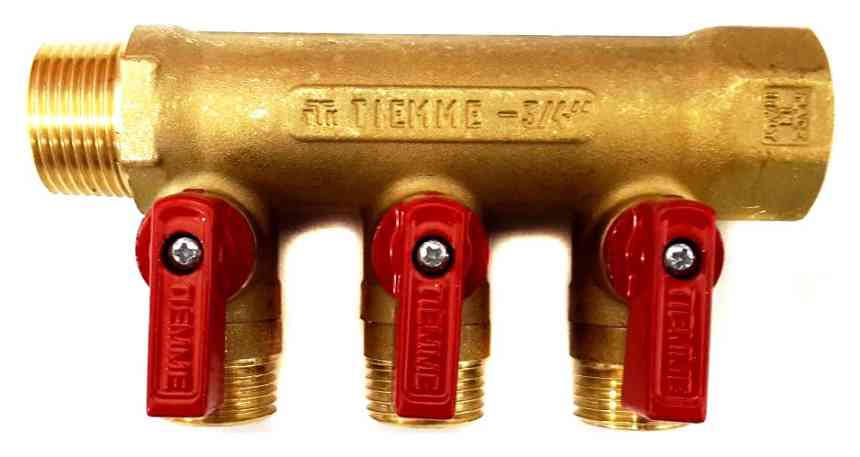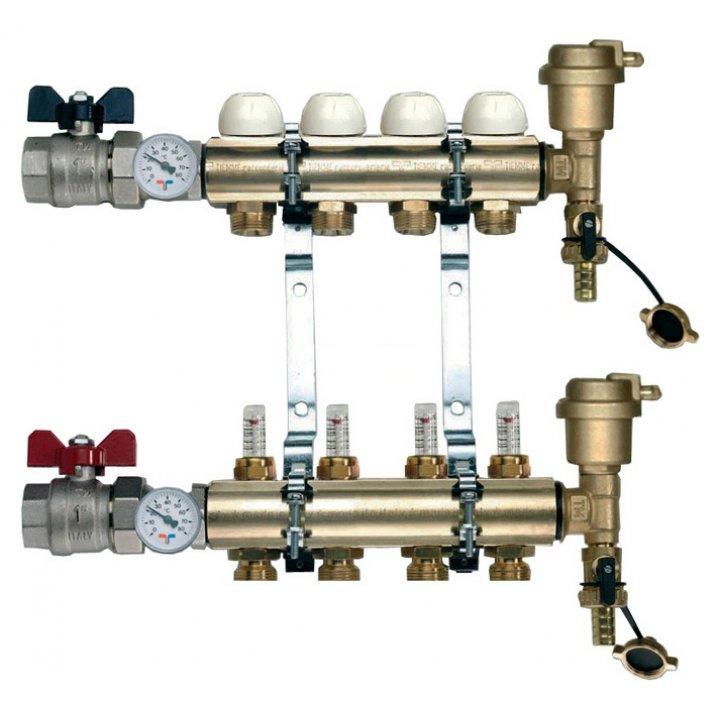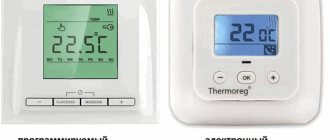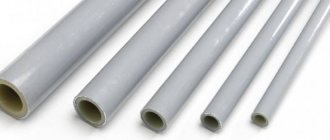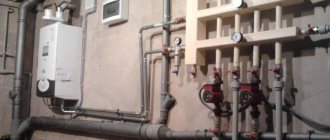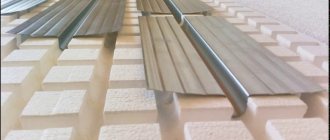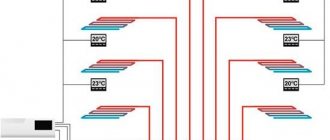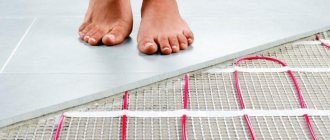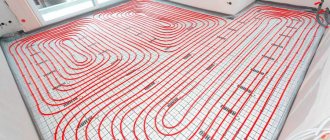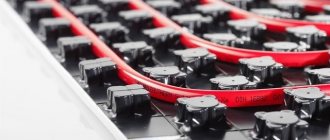The specifics of using solar collectors
The main feature of solar collectors, which distinguishes them from other types of heat generators, is the cyclical nature of their operation. If there is no sun, there is no heat energy either. As a result, such attitudes are passive at night.
Average daily heat production directly depends on the length of daylight hours. The latter is determined, firstly, by the geographical latitude of the area, and secondly, by the season. During the summer period, which is the peak of insolation in the Northern Hemisphere, the collector will work with maximum efficiency. In winter, its productivity falls, reaching a minimum in December-January.
In winter, the efficiency of solar collectors decreases not only due to a decrease in the duration of daylight hours, but also due to a change in the angle of incidence of sunlight. Fluctuations in solar collector performance throughout the year should be taken into account when calculating its contribution to the heat supply system.
Another factor that can affect the productivity of the solar collector is the climatic features of the region. On the territory of our country there are many places where the sun is hidden behind a thick layer of clouds or behind a veil of fog for 200 or more days a year. In cloudy weather, the performance of the solar collector does not drop to zero, since it is able to capture scattered sunlight, but it significantly decreases.
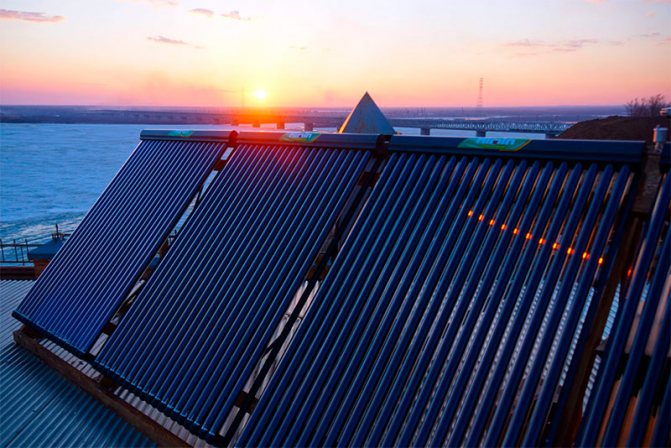
Manifold mounting
Collectors are made of brass, stainless steel, polyethylene or polypropylene.
Polymers are not inferior in strength to metal, and such products can be operated with the same efficiency. Metal manifolds are threaded. The plastic is soldered, and the metal-plastic elements are joined by means of special couplings.
If you contact a specialized company, a final estimate will be provided, which indicates the prices for all component systems and installation work.
When the decision is made to assemble the system with your own hands, you need to take into account a number of features and recommendations of specialists:
- The purchase kit should include those goods that will be needed during assembly.
- The connections can be combined, involving the transition from metal to plastic or metal-plastic in any combination.
- The number of taps is equal to the number of connected devices. Usually, one to six taps are enough in an apartment.
- It is allowed to connect two or more collectors in series with a different number of taps.
- Different collectors are used for cold and hot water.
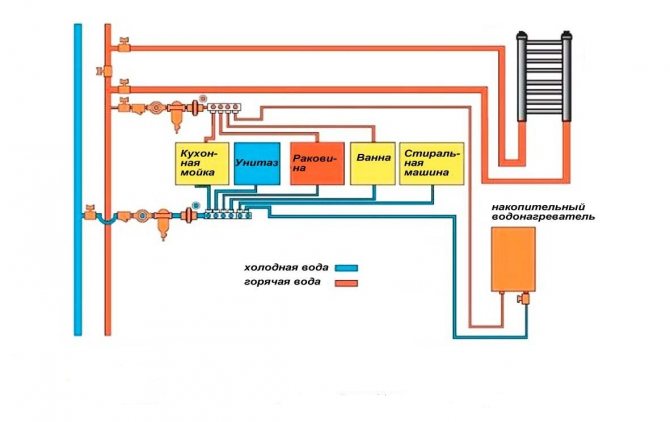

Collector type water supply scheme
The choice of materials and components is not the only feature. The work is also performed using a number of rules. But the main differences lie in the type of system. This can be cold or hot water supply, as well as heating.
Water supply
When choosing pipes, you need to take into account the temperature regime. For hot water, metal and metal-plastic pipes are suitable, if the latter have special markings. The cold water supply system can be organized using plastic pipes. However, it should be borne in mind that they should not be bricked up due to the fact that they are subject to a high degree of thermal deformation.
The use of technology is allowed when the wiring is hidden in the walls or floor. There are a number of limitations here. Walls cannot be reinforced concrete, load-bearing structures. Ceilings made of hollow core slabs cannot be channeled. But if the house is made of bricks, and the floor is a monolithic slab on the ground, this can be done. An alternative is screed pipes.
Heating
The peculiarity of the collector wiring is the separate connection of each radiator, room, floor, etc. this saves the coolant. If a part of the house is not used and it does not need to be heated, it is enough to turn it off or reduce circulation, while maintaining an acceptable minimum.
The advantages of such a system are similar to the advantages of identical plumbing systems. There is no need to shut down the boiler during repair and maintenance. But the disadvantages are the same. A large amount of spent materials, the complexity of installation, and as a result, a large estimated cost. But having embedded the pipes in the screed, it is possible to assemble the "warm floor" system. Then the pipeline and radiators will not spoil the interior of the room.
The principle of operation and types of solar collectors
Now is the time to say a few words about the structure and operation of the solar collector. The main element of its design is an adsorber, which is a copper plate with a pipe welded to it. Absorbing the heat of the sun's rays falling on it, the plate (and with it the pipe) heats up quickly. This heat is transferred to the liquid heat carrier circulating through the pipe, which, in turn, transports it further through the system.
The ability of the physical body to absorb or reflect the sun's rays depends primarily on the nature of its surface. For example, a mirror surface perfectly reflects light and heat, but a black one, on the contrary, absorbs. That is why a black coating is applied to the copper plate of the adsorber (the simplest option is black paint).
How the solar collector works
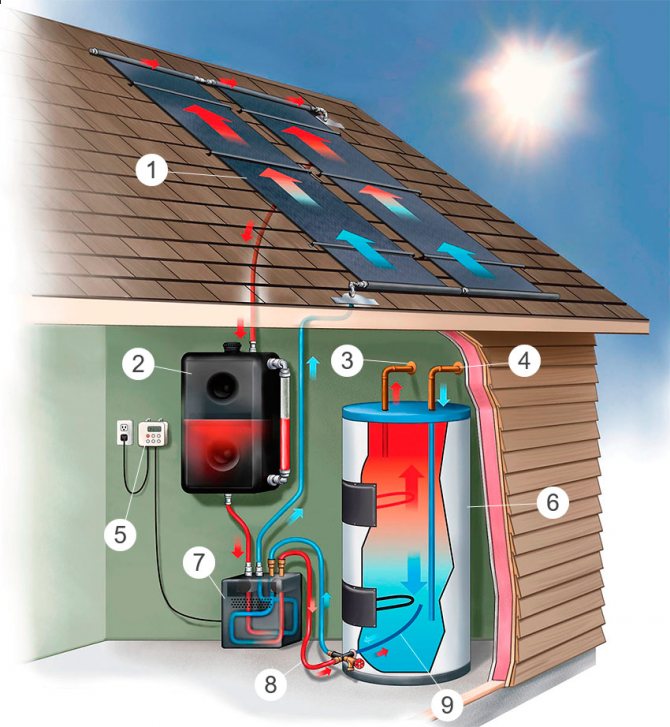

1. Solar collector. 2. Buffer tank. 3. Hot water.
4. Cold water. 5. Controller. 6. Heat exchanger.
7. Water pump. 8. Hot stream. 9. Cold stream.
It is also possible to increase the amount of heat received from the sun by choosing the correct glass covering the adsorber. Ordinary glass is not transparent enough. In addition, it glares, reflecting some of the incident sunlight. In solar collectors, as a rule, they try to use special glass with a low iron content, which increases its transparency. To reduce the proportion of light reflected by the surface, an anti-reflective coating is applied to the glass. And so that dust and moisture do not get inside the collector, which also reduce the throughput of the glass, the case is made sealed, and sometimes even filled with an inert gas.
Despite all these tricks, the efficiency of solar collectors is still far from 100%, which is due to the imperfection of their design. The heated adsorber plate radiates part of the received heat into the environment, heating the air in contact with it. To minimize heat loss, the adsorber must be insulated. The search for an effective way to insulate the adsorber led engineers to create several types of solar collectors, the most common of which are flat and tubular vacuum collectors.
Flat solar collectors
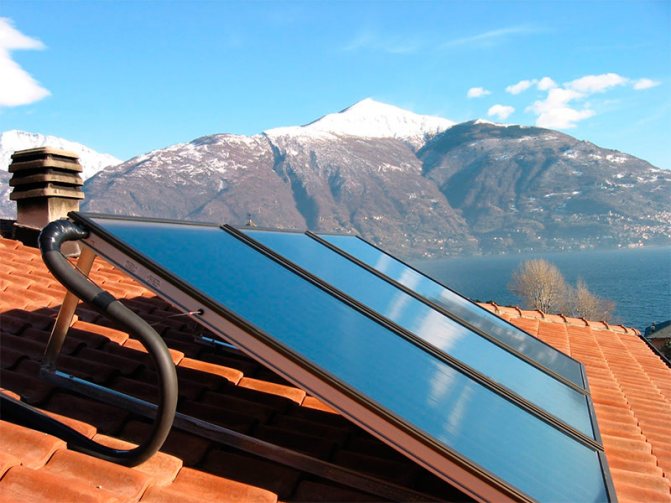

Flat solar collectors.
The design of a flat solar collector is extremely simple: it is a metal box covered with glass on top. As a rule, mineral wool is used for thermal insulation of the bottom and walls of the case. This option is far from ideal, since the transfer of heat from the adsorber to the glass by means of the air inside the box is not excluded. With a large temperature difference inside the collector and outside, heat losses are quite significant. As a result, a flat solar collector, which functions perfectly in spring and summer, becomes extremely ineffective in winter.
Flat solar collector device
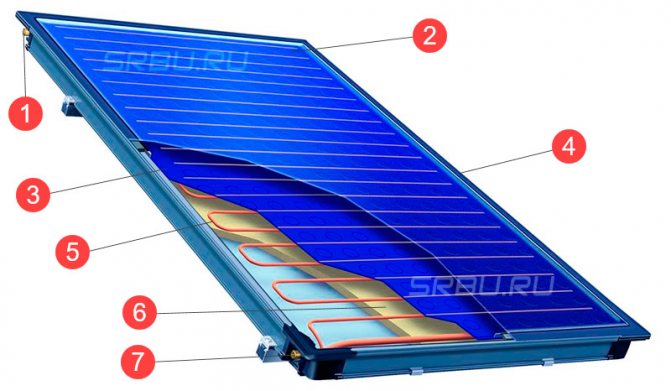

1. Inlet pipe. 2. Safety glass.
3. Absorption layer. 4. Aluminum frame.
5. Copper tubes. 6. Heat insulator. 7. Outlet pipe.
Tubular vacuum solar collectors


Tubular vacuum solar collectors.
A solar vacuum collector is a panel made up of a large number of relatively thin glass tubes. An adsorber is located inside each of them. To exclude the transfer of heat by gas (air), the tubes are evacuated. It is due to the absence of gas near the adsorbers that vacuum collectors have low heat losses even in frosty weather.
Vacuum manifold device


1. Thermal insulation. 2. Heat exchanger housing. 3. Heat exchanger (collector)
4. Sealed plug. 5. Vacuum tube. 6. Capacitor.
7. Absorbing plate. 8. Heat pipe with working fluid.
What is and what is a water supply collector for?
A water supply manifold is a device that divides one significant water flow into several smaller ones. To ensure sufficient head in the device, the radius of the entrance is approximately 20-40% larger than that of the exit.
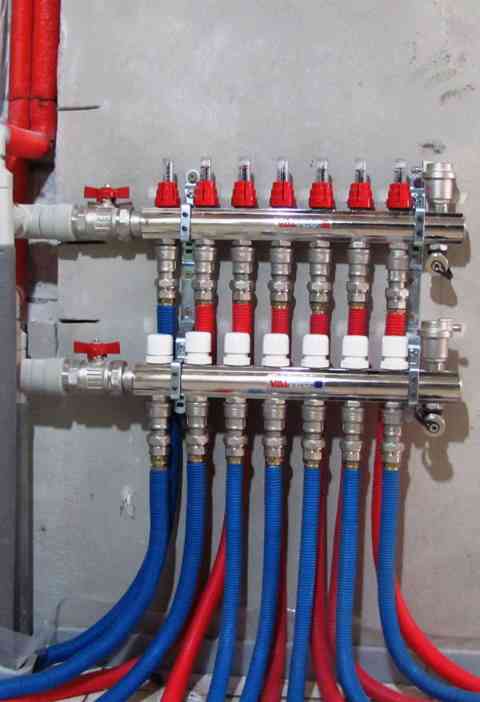

water supply manifold
The water distribution manifold is a hollow cylindrical structure that is used for correct and equal distribution of liquid between different consumers. This device is used for parallel branching of pipes. The device allows you to normalize the pressure, thereby preventing the occurrence of water hammer.
It is believed that the collector system is much more efficient than the classic one, consisting of risers and tees. Despite this, the cost of such a design is much higher. That is why, before giving preference to one or another option, it is necessary to understand all the features of the collector's operation and the rules for its installation.
Applications of solar collectors
The main purpose of solar collectors, like any other heat generators, is to heat buildings and prepare water for a hot water supply system. It remains to find out which type of solar collectors is best suited to perform a particular function.
Flat solar collectors, as we found out, have good performance in the spring and summer, but are ineffective in winter. From this it follows that using them for heating, the need for which appears precisely with the onset of cold weather, is impractical. This, however, does not mean that there is no business at all for this equipment.
Flat collectors have one indisputable advantage - they are significantly cheaper than vacuum models, therefore, in cases where it is planned to use solar energy exclusively in the summer, it makes sense to purchase them. Flat solar collectors perfectly cope with the task of preparing water for hot water supply in the summer. Even more often they are used to warm water to a comfortable temperature in outdoor pools.
Tubular vacuum collectors are more versatile. With the arrival of winter cold, their performance does not decrease as much as in the case of flat models, which means that they can be used all year round. This makes it possible to use such solar collectors not only for hot water supply, but also in the heating system.
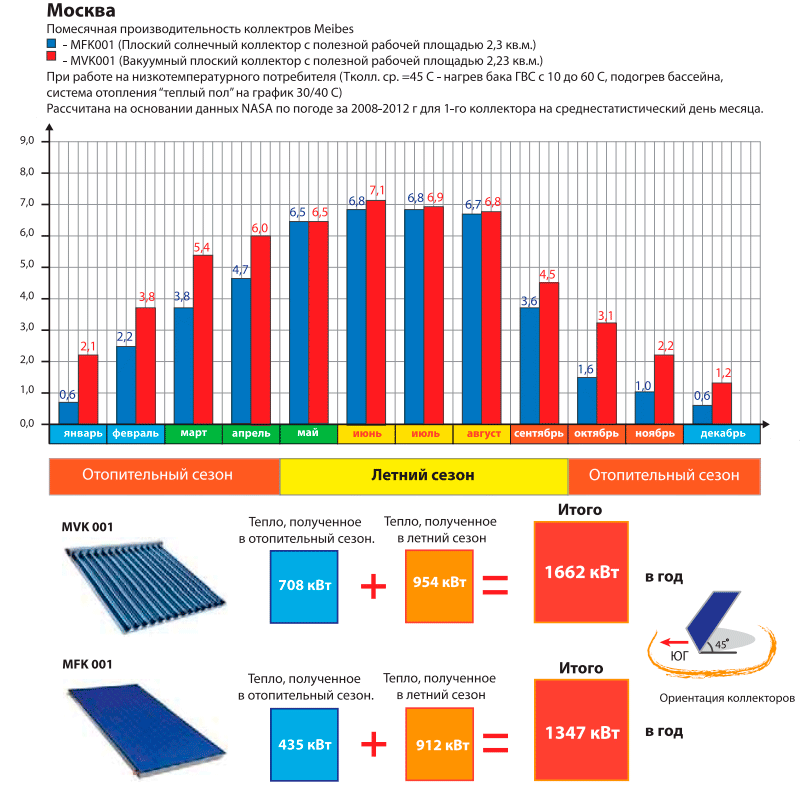

Comparison of flat and vacuum solar collectors.
Why do you need a collector
When installing new or replacing old plumbing, the location of water consumption points is taken into account: a washing machine, a toilet bowl, a sink, and others.
In standard modern apartments, the number of plumbing fixtures ranges from 4 to 10 units. With this amount, knowledgeable plumbers advise installing a distribution manifold.
It is an essential component of hot and cold water or heating systems. It is installed on a central riser in a sanitary cabinet and distributes a single stream of water into several with equal pressure of the jet in each.
Arrangement of solar collectors
The efficiency of a solar collector directly depends on the amount of sunlight falling on the adsorber. It follows from this that the collector should be located in an open space, where a shadow from neighboring buildings, trees located near mountains, etc. never falls (or at least for the longest time).
It is not only the location of the collector that matters, but also its orientation. The most "sunny" side in our northern hemisphere is the southern one, which means, ideally, the "mirrors" of the reservoir should be turned strictly to the south. If it is technically impossible to do this, then you should choose the direction as close as possible to the south - southwest or southeast.
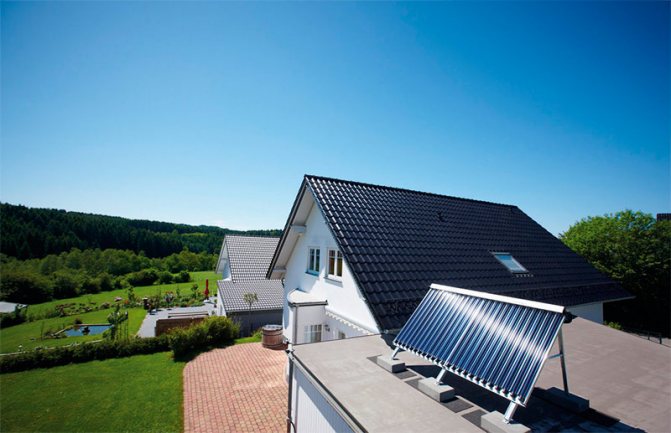

One should not lose sight of such a parameter as the angle of inclination of the solar collector. The value of the angle depends on the deviation of the position of the Sun from the zenith, which in turn is determined by the latitude of the area in which the equipment will be operated. If the angle of inclination is not set correctly, then the optical energy loss will increase significantly, since a significant part of the sunlight will be reflected from the collector glass and, therefore, will not reach the absorber.
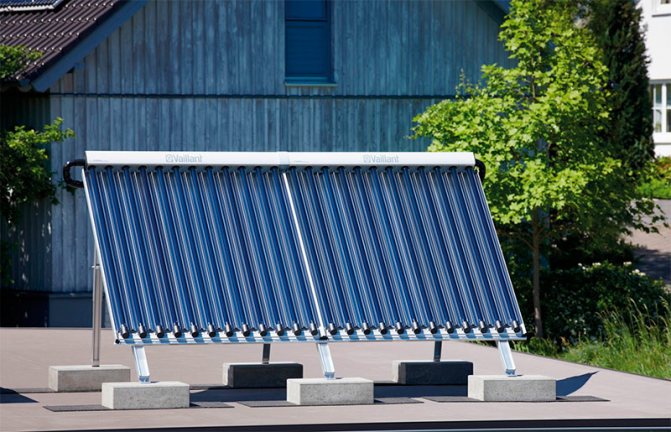

Collector device
The manifold is connected to the cylinder head, of course, there is an exhaust manifold gasket between them, thanks to which the exhaust gases do not escape into the engine compartment. The gasket is made of special materials, which ensures its long service life. If necessary, you can replace the exhaust manifold gasket, fortunately, on most cars this procedure is quite simple and quick. An exhaust pipe, or catalytic converter, is connected to the other end of the manifold.
How to choose a solar collector of the right power
If you want the heating system of your home to cope with the task of maintaining a comfortable temperature in the premises, and hot, not lukewarm water flowed from the taps, and at the same time plan to use a solar collector as a heat generator, you need to calculate the required equipment power in advance.
At the same time, it will be necessary to take into account a fairly large number of parameters, including the purpose of the collector (hot water supply, heating or their combination), the object's heat demand (total area of heated rooms or average daily hot water consumption), climatic features of the region, features of the collector installation.
In principle, making such calculations is not so difficult. The performance of each model is known, which means that you can easily estimate the number of collectors required to provide the house with heat. Companies engaged in the production of solar collectors have information (and can provide it to the consumer) about the change in the power of the equipment depending on the geographical latitude of the area, the angle of inclination of the "mirrors", the deviation of their orientation from the south direction, etc., which makes it possible to make the necessary corrections when calculating the performance of the collector.
When selecting the required collector capacity, it is very important to achieve a balance between lack and excess of generated heat. Experts recommend focusing on the maximum possible collector capacity, that is, using the indicator for the most productive summer season in the calculations. This goes against the desire of the average user to take equipment with a margin (that is, to calculate by the power of the coldest month), so that the heat from the collector is enough even on less sunny autumn and winter days.
However, if you choose a solar collector with increased power, then at the peak of its performance, i.e.in warm sunny weather, you will face a serious problem: more heat will be produced than consumed, and this threatens overheating of the circuit and other unpleasant consequences. There are two options for solving this problem: either install a low-power solar collector and connect backup heat sources in parallel in winter, or purchase a model with a large power reserve and provide for ways to discharge excess heat in the spring-summer season.
Products on the market
Depending on the material, the cost of products ranges from 400 to 2500 rubles. Collector groups for 200-300 outputs can cost 10,000-40,000 rubles.
There are models from different manufacturers on the market, popular ones include:
- Watts;
- Uponor;
- Giacomini;
- APC;
- Luxor;
- Fado;
- Caleffi;
- Valtec;
- Bianchi.
The stores offer not only combs, but also accessories. Products without taps are economical. They are used to set up individual wiring, make it possible to choose the right parts. Purchasing a product with shut-off valves will facilitate the installation process. When assembling units, the need to install valves disappears.
Components are purchased to adapt the device to the home system. These include valves, valves, pumping groups. Mechanical actuators, plugs and fittings are required.
Manifold cabinets are used for wall mounting and maintaining an aesthetic appearance.
System stagnation
Let's talk a little more about the problems associated with an excess of generated heat. So, let's say that you have installed a sufficiently powerful solar collector that can fully provide heat to the heating system of your home. But summer has come, and the need for heating has disappeared. If you can turn off the power supply for an electric boiler, or cut off the fuel supply for a gas boiler, then we have no power over the sun - we cannot “turn it off” when it gets too hot.
System stagnation is one of the major potential problems for solar collectors. If not enough heat is taken from the collector circuit, the coolant overheats. At a certain moment, the latter can boil, which will lead to the termination of its circulation along the circuit. When the coolant cools down and condenses, the system will resume operation. However, not all types of heat transfer fluids calmly transfer the transition from a liquid to a gaseous state and vice versa. Some, as a result of overheating, acquire a jelly-like consistency, which makes further operation of the circuit impossible.
Only a stable removal of the heat produced by the collector will help to avoid stagnation. If the calculation of the power of the equipment is made correctly, the probability of problems is practically zero.
However, even in this case, the occurrence of force majeure is not excluded, therefore, methods of protection against overheating should be foreseen in advance:
1. Installation of a reserve tank for accumulating hot water. If the water in the main tank of the hot water supply system has reached the set maximum, and the solar collector continues to supply heat, it will automatically switch over and the water will begin to heat up already in the reserve tank. The created supply of warm water can be used for domestic needs later, in cloudy weather.
2. Heated pool water. Owners of houses with a swimming pool (whether indoor or outdoor) have an excellent opportunity to remove excess heat energy. The volume of the pool is incomparably greater than the volume of any household storage device, which means that the water in it will not heat up so much that it will no longer be able to absorb heat.
3. Draining hot water. In the absence of the opportunity to spend excess heat usefully, you can simply drain the heated water in small portions from the storage tank for hot water supply into the sewer.At the same time, the cold water entering the tank will lower the temperature of the entire volume, which will continue to remove heat from the circuit.
4. External heat exchanger with fan. If the solar collector has a large capacity, the excess heat can also be very large. In this case, the system is equipped with an additional circuit filled with refrigerant. This additional circuit is connected to the system by means of a heat exchanger equipped with a fan and mounted outside the building. If there is a risk of overheating, excess heat enters the additional circuit and is "thrown" into the air through the heat exchanger.
5. Discharge of heat into the ground. If, in addition to the solar collector, the house has a ground source heat pump, the excess heat can be directed into the well. At the same time, you solve two problems at once: on the one hand, you protect the collector circuit from overheating, on the other hand, you restore the heat reserve in the soil depleted during the winter.
6. Isolation of the solar collector from direct sunlight. From a technical point of view, this method is one of the simplest. Of course, it's not worth climbing onto the roof and covering the collector manually - it's hard and unsafe. It is much more rational to install a remotely controlled shutter, like a roller shutter. You can even connect the damper control unit to the controller - in case of a dangerous increase in temperature in the circuit, the manifold will close automatically.
7. Draining the coolant. This method can be considered cardinal, but at the same time it is quite simple. If there is a risk of overheating, the coolant is drained by means of a pump into a special tank integrated into the system circuit. When conditions become favorable again, the pump will return the coolant to the circuit, and the collector will be restored.
Sewer collector what is it and photo
Sewer collector - a system of pipes and pipelines is called, designed to drain sewage and drains to a collection point, for which a tank or simply a cesspool usually serves.
This is the most standard device for a sewer well, however, there are other, more complex, but also more practical, sealed and non-toxic soils.
Absolutely all types can be equipped with your own hands, you only need an investment of finance and labor costs.
Methods for arranging a sewer collector
Sewer collector - called a system of pipes and pipelines, designed to drain sewage and drains to the collection point
It should be noted right away that this is not a heating manifold, but another device, which is a line from a system of pipes laid in trenches. Sometimes a sewer structure is called a channel, and this makes it clearer what a sewer collector is and why it is needed.
An ordinary cesspool is a device that receives all the drains. At the same time, the pit can be equipped literally in a matter of hours, simply by tearing out a foundation pit on the site, overlapping it with a brick or something else, as shown in the photo. In this case, one must not forget that the drain must be cleaned by means of a sewer.
A septic tank is another option for collecting sewage and drains. As shown in the photo, this is a sealed structure, where a piping system that transports waste from plumbing fixtures fits.
Such a device requires some preparatory work, but the general principle is the same: a pit is dug, where the tank is mounted, drain pipelines are supplied to it, and then the sewer collector is put into operation.
Sewer collector installation
Sewer collector is an important part of the sewerage system, without which it is impossible to equip an autonomous structure
The collector device is shown at the stage of laying the foundation. The process is simple and does not take much time:
- Below the freezing point of the soil, a trench is being dug under the pipeline;
- A sand cushion (up to 20 cm thick) is laid at the bottom of the trench, rammed;
- Pipes are placed on top. For a gravity sewerage system, the pipeline is installed with a slope towards the collector tank. The maximum slope size is 2 cm per 1 m of the pipe;
- The pipeline is insulated;
- The tightness of the joints of the elements is checked by filling the structure with water;
- The trench is buried, the outlet of the pipeline is preliminarily lowered into a pit or connected to a septic tank, as shown in the photo.
The system is mounted in pressure structures, which are equipped in the case when gravity sewage is not possible for installation for one reason or another. The pressure sewerage system consists of a reservoir for collecting wastewater, a pipeline.
The line of pipes laid in the trenches rises as it approaches the sewage tank, and so that the streams do not stagnate, the sewer collector is equipped with a pump.
Such a system makes it easy to lay sewers on any terrain and helps to increase the cleanliness of the system as much as possible.
Other system components
It is not enough to simply collect the heat radiated from the sun. It still needs to be transported, accumulated, transferred to consumers, all these processes need to be monitored, etc. This means that in addition to the collectors located on the roof, the system contains many other components, which may be less noticeable, but no less important. Let's focus on just a few of them.
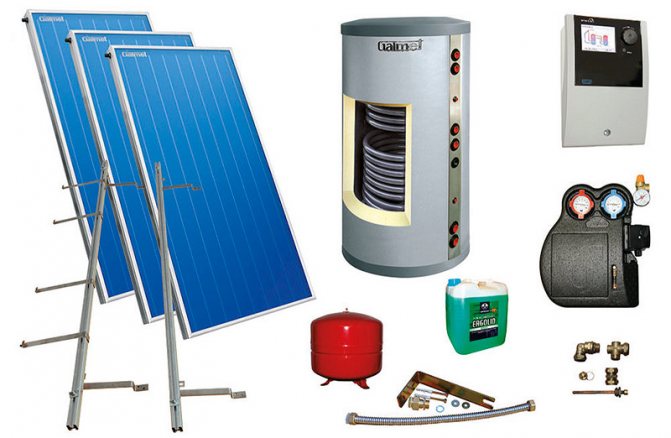

Heat carrier
The function of the coolant in the collector circuit can be performed either by water or by an anti-freeze liquid.
Water has a number of disadvantages that impose certain restrictions on its use as a coolant in solar collectors:
- First, at negative temperatures, it solidifies. To prevent the frozen coolant from bursting the pipes of the circuit, with the approach of cold weather it will have to be drained, which means that in winter you will not receive even small amounts of thermal energy from the collector.
- Secondly, a not too high boiling point of water can cause frequent stagnation in the summer.
Non-freezing liquid, unlike water, has a significantly lower freezing point and incomparably higher boiling point, which increases the convenience of using it as a heat carrier. However, at high temperatures, "non-freezing" can undergo irreversible changes, so it should be protected from excessive overheating.
Pump adapted for solar systems
To ensure the forced circulation of the coolant along the collector circuit, a pump adapted for solar systems is required.
DHW heat exchanger
Heat transfer from the solar collector circuit to the hot water supply or to the heating medium of the heating system is carried out by means of a heat exchanger. As a rule, a large-volume tank with a built-in heat exchanger is used to accumulate hot water. It is rational to use tanks with two or more heat exchangers: this will allow taking heat not only from the solar collector, but also from other sources (gas or electric boiler, heat pump, etc.).
Reservoir classification
Devices are created from different materials:
- brass;
- polypropylene;
- made of cross-linked polyethylene;
- made of stainless steel.


Stainless steel


Polypropylene


Brass
Devices are classified according to the method of connecting pipes. Threaded fastening implies the presence of an internal or external thread. The connection is made using a Eurocone or using compression fittings for pipes made of metal-plastic and plastic.
For water supply pipes made of polypropylene, plastic fittings for soldering are still used. But products made of cross-linked polyethylene cannot be connected like that, compression fittings will be required.
The collector unit has a different number of outputs: from 2 to 6.The products are equipped with two fasteners corresponding to the section of the main pipe. With their help, several blocks are combined into one device without the use of additional transition parts. An increase in the length of the comb is necessary in cottages with a large number of plumbing fixtures.
It happens that only one device is installed. Then special plugs are used to close the unused outputs.
The devices block the flows to some consumers, while the rest continue to work. This helps when repairing or replacing plumbing, restoring a damaged area, or cleaning a plumbing.
